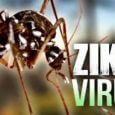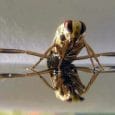Parasitoid Flies Are Attracted to the Sounds of Their Cicada Hosts July 5, 2016 by Entomology Today Leave a Comment

By Ed Ricciuti
Scientists have pondered why males of certain parasitoid fly species have ears that apparently function well enough but, as the Bible says, seemingly “do not hear,” while females with exactly the same auditory apparatus sonically locate cicadas, grasshoppers, crickets, and other hosts for their larvae. However, according to research published in the Journal of Insect Science, males of at least one fly species, Emblemasoma erro, are very good listeners indeed. Apparenty, the song of the cicada draws gravid E. erro females looking to deposit their larvae, and it also puts non-gravid females and males in the mood for love.

Ed Ricciuti
“Every summer, the grasslands of the central Great Plains ring with the mating calls of male cicadas that are trying to attract female cicadas,” said Dr. Brian J. Stucky, author of the article.
But unfortunately for the cicadas, their song also attracts the unwelcome attention of gravid female E. erro flies that “eavesdrop” on the signals and follow them to their source. In addition, male and female flies that are ready to reproduce hear the cicadas, home in on them, and, in many cases, mate.
Located on the thorax, the ear of E. erro is typical of insects — a tightly stretched membrane that functions much like the human eardrum, which vibrates when contacted by sound waves and transmits these to sensory cells.
The fly studied by Stucky is a member of the family Sarcophagidae, which are commonly called “flesh flies” because some species deposit offspring in carrion or wounds, while others, including E. erro, drop maggots on insects. E. erro parasitizes cicadas in grasslands between the Rocky Mountains and the Mississippi River.
From 2011 to 2013, late July to early September, Stucky drove his automobile to the prairies of central Kanas, parked, and then hauled his equipment under broiling sun to his research sites. Once set up, he broadcasted cicada calls with a loudspeaker mounted on a wooden box and observed flies of both sexes arriving and hanging out, as if in a veritable fly singles bar.
Some of the female arrivals were gravid, but, importantly, many of them were not, so deposition of larvae was not their goal. Indeed, males and females both demonstrated that they had procreation in mind. Males repeatedly attempted to mate with other arriving flies, including other males, and some managed to do so with females.
Stucky reaffirmed his observations by catching and counting flies that responded to the cicada calls in three different traps, with varying durations and volumes of the cicada signals. All told, he captured 110 flies, about 75 percent of which were females, including several that were not carrying larvae and thus not looking to infect the host. He reasoned that the flies had come to mate when they heard and flew to the cicada sound. Otherwise, the trip would have been an unproductive waste of time and energy.
A close relative of E. erro called E. auditrix also uses a cicada host, to which females are attracted by sound, but the ears of male E. auditrix have been described as “useless” in the scientific literature. Stucky’s research shows that scientists should not make generalizations about all species within a group.
“Hearing is a multi-functional sense in insects,” he said.
In the case of the flies he studied, Stucky suggests that “hearing may have originated as a means of finding a host but has become useful in another way as well.”
Read more at:
Ed Ricciuti is a journalist, author, and naturalist who has been writing for more than a half century. His latest book is called Bears in the Backyard: Big Animals, Sprawling Suburbs, and the New Urban Jungle (Countryman Press, June 2014). His assignments have taken him around the world. He specializes in nature, science, conservation issues, and law enforcement. A former curator at the New York Zoological Society, and now at the Wildlife Conservation Society, he may be the only man ever bitten by a coatimundi on Manhattan’s 57th Street.



